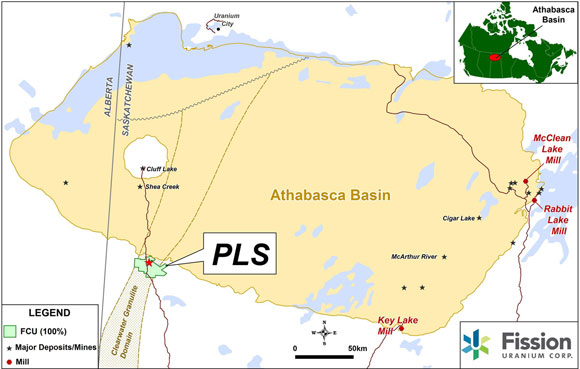TICKERS: , AMZ, EPB, ETE, ET, EPD, NYSE, WES
Yves Siegel: Baby Boomers Attracted to MLP Yields
Interview
Source: Brian Sylvester of The Energy Report (5/24/11)
 Master limited partnerships (MLPs) are growing in popularity as baby boomers nearing retirement flock to yield. In this exclusive interview with The Energy Report, Credit Suisse Managing Director and Senior Analyst Yves Siegel targets MLPs that are still growing faster than this burgeoning sector and dispels rumors that MLPs could be subject to new taxes.
Master limited partnerships (MLPs) are growing in popularity as baby boomers nearing retirement flock to yield. In this exclusive interview with The Energy Report, Credit Suisse Managing Director and Senior Analyst Yves Siegel targets MLPs that are still growing faster than this burgeoning sector and dispels rumors that MLPs could be subject to new taxes.
The Energy Report: Yves, when you last spoke with The Energy Report in August, you said that MLPs are viewed as good defensive investments in times of uncertainty. Now that the economy is starting to find its feet—growing at an annual rate of 3.8% and adding about 250,000 jobs last month—does that mean MLPs are less attractive than they were a year ago?
Yves Siegel: MLPs still are very attractive because investors continue to gravitate toward yield securities in a low interest-rate environment. Despite economic progress, there is still a lot of uncertainty in the markets and there's still concern that economic growth is less robust than it should be in a typical recovery. MLPs still are quite attractive, and investors still are looking for yield.
TER: Why are people looking for investments that are producing income?
YS: Demographics are dictating the search for yield. As baby boomers start to retire, they are looking for vehicles with relatively low risk, such as MLPs. Also, investors are concerned about inflation. Typically, the distribution growth at MLPs is able to keep investors ahead of inflation. As the population ages and its investment time horizon shortens, there's less ability to recover from a bad investment decision. Investors want to dial their risk profiles down a little bit.
TER: But even MLPs aren't without risk. Last week, the Alerian MLP Index (NYSE:AMZ) fell by almost 2% after the National Association of Publicly Traded Partnerships (NAPTP) reported the Obama administration is considering a proposal to tax pass-through entities, such as MLPs. What impact could that have on the sector and its risks?
YS: That created quite a stir, but actually the Obama administration is only considering various tax proposals. No plan has been written; in fact, it's a low probability because there's not a whole lot of traction to tax pass-through entities. Having said that, I think it is always a risk that what legislation giveth, legislation can taketh away. In the late '80s, tax legislation narrowed the scope of income that qualified for MLP status to natural resource companies primarily. The rationale was based on concerns about tax leakage and too many companies deciding to become partnerships as a way to mitigate tax liability. That legislation significantly narrowed the scope of what qualified to be in a MLP.
A few years ago, Canada changed its tax legislation, as it related to royalty trusts, and that spooked the market for MLPs. Clearly, Canada was just mimicking what the U.S. had done—narrowing the scope to qualify. Canada was concerned about too many conversions to royalty trusts. If legislation changed, that would have a negative impact on MLPs; but the likelihood is very high that there will not be a change at this point in time.
TER: One of the barometers for the health of MLPs is the yield spread to 10-Year Treasuries. What's the current yield spread?
YS: The current yield spread is around 275 basis points, or 2.75%. MLPs, in aggregate, are trading at about a 6% yield. The 10-Year Treasury is around 3.25%.
TER: At the beginning of 2011, it was 382 points on a 5-year average. It's down about 100 basis points from that. Does that demonstrate a bit of weakness in the current market?
YS: It actually suggests that MLPs have been strong, and the valuations are no longer as cheap as they were at the beginning of the year. MLPs have done well as an investment because investors are searching for yield, and MLPs have been able to grow their distributions. There's more demand for MLPs, so the price has gone up. When the price goes up, the yield spread relative to 10-Year Treasuries tightens. So, what does that mean to me? It means that I would not characterize the MLPs as being overpriced. I think they're more fairly priced today than they have been over the past several years, but it's a mistake when investors look solely at that spread. I would argue that, when interest rates are high, the spread to the 10-Year Treasury is high.
Take an extreme case: If the 10-Year Treasury is yielding 8%, investors probably need more than a 12% yield, or 400 basis points to the 10-Year Treasury, to coax them into an alternative investment type. However, when interest rates are lower as when the 10-Year Treasury is down to the 3% range, then a 6% yield is pretty attractive in my mind. It's not just the absolute spread—it's the relative spread. Another argument in favor of MLPs is that, as they gain prominence, investors might come to the conclusion that they don't need 400 basis points or 4% more to invest in them. They will feel comfortable with the investment, so maybe all they will need is 250 basis points.
TER: A total of 13 new MLP products launched in 2010: 7 exchange traded funds (ETFs), 3 closed-end funds and 3 open-end funds. Those products raised roughly $4.5 billion. Are we seeing similar sector growth in 2011?
YS: There are more closed-end funds. You do have folks looking at new exchange traded notes (ETNs) and new ETFs. It speaks to the fact that investors increasingly are looking for yield. There's recognition that MLPs are a good place to invest and satisfy that investment criterion.
TER: Let's talk about those distributions. Median distribution growth reached a high of about 11% in 2008 before falling to 3% in 2009. It also was around 3% in 2010. What are your projections for 2011?
YS: We think distribution growth will continue to grow in the 4%–5% range on average. What's driving that growth is, most importantly, the new investments around energy infrastructure. MLPs have been very good stewards of capital. They're investing money well in excess of their capital costs. Those excess returns are enabling them to raise distributions. Also, I think the base business is growing. There's more demand for commodities and more gasoline demand, so there will be more volume through their pipelines. That can impact cash flow and the ability to pay higher distributions.
TER: There's a bit of a feeling that there's a bottom there, too.
YS: That type of growth rate is not sustainable, part of it has to do with the fact that there were a number of MLP initial public offerings in the mid 2000s. Those companies were able to grow the distributions faster than mature companies. I think that growth rate also included the general partners (GPs). Typically, the publicly traded GPs can grow their distributions twice as fast as the underlying MLP. The combination of small MLPs coming to market and being able to grow faster and the GPs growing faster than normal raised the distribution growth to levels (i.e., 11%) that are now just not sustainable.
TER: What are some names that are growing distribution growth faster than the sector as a whole?
YS: Right now, the companies that are showing really good growth are Western Gas Partners, L.P. (NYSE:WES), El Paso Pipeline Partners, L.P. (NYSE:EPB) and Chesapeake Midstream Partners, L.P. (NYSE:CHKM). What those three companies have in common is that they're able to acquire assets from parent companies that continue to be very accretive to the underlying unitholders.
TER: Are MLP valuations fairly relative to historic valuation metrics, or is there still some value to be found out there?
YS: Yes, MLPs are fairly valued relative to historic metrics. But is there still value to be found? I think the answer to that also is yes, because the value proposition is such that you have a 6% average yield and distribution growth of 5%; so, all else being equal, that would equate to a roughly 11% total return. From a risk-reward comparison, I'd be challenged to find other investments that could generate that kind of total return without reaching further out on the risk spectrum.
TER: Energy Transfer Partners, L.P. (NYSE:ETP) built the Fayetteville Express Pipeline to access the Haynesville Shale. It spent billions of dollars to build both pipelines. Is the company starting to reap the rewards of those investments?
YS: The answer is yes. The Tiger and Fayetteville Pipelines both came onstream in January. Energy Transfer Partners has an incremental expansion project yet to happen on the Tiger. It also made a key $2B acquisition of Louis Dreyfus Highbridge Energy LLC's assets as a joint venture (JV) with Regency Energy Partners, L.P. (NASDAQ:RGNC). It's starting to invest in the natural gas liquids (NGL) value chain for two purposes: 1) Its customers are drilling more natural, rich gas, so ETP is expanding its service capabilities to handle the NGL transfer needs of its clients; and 2) The company believes it can get a very nice return on that investment.
TER: What are your ratings on Energy Transfer, Chesapeake, Western Gas and El Paso?
YS: We have an Outperforming rating on Energy Transfer Partners and a 12-month target price of $56. We also have an Outperform rating on its general partner, Energy Transfer Equity, L.P. (NYSE:ETE), with a $47 price target. Western Gas has a $36 price target and, formally, we don't have ratings on Chesapeake or El Paso.
TER: Are there any other MLPs that you're excited about?
YS: We think that Enterprise Products Partners, L.P. (NYSE:EPD) is very strong. I would characterize Enterprise as a core holding in the MLP space—it's the largest MLP today. It has a very strong foothold in the NGL value chain that Energy Transfer is now entering. It also has a very strong capital program, spending several billions of dollars providing infrastructure in the Eagle Ford Shale play, which is one of the most-prolific plays in the U.S. today. We have a target price of $45 on Enterprise.
The other interesting thing about Enterprise Products Partners is that it has steady 5% distribution growth. It has consistently been able to grow the distribution at 5% with excess coverage. Over the last several years, where the typical MLP business model is to pay out all of its cash flow in the form of distributions, EPD has paid out roughly 80% of its available cash flow and reinvested close to $2B of it in the business. That is unique.
TER: Is that because most MLPs pay it all out?
YS: Yes, with a much skinnier coverage ratio.
TER: Do you think that more companies are likely to adopt that strategy as time goes on?
YS: I don't think so. The reason this is unique to EPD is the vision of its founder, Dan Duncan, who believes that cost of capital is very important. Enterprise was one of the first to restructure its incentive distribution rights. Its view of managing capital is much different than that of a lot of companies. I think the company has the right model, but it took it a long time to get there. I don't think other companies are going to adapt that model anytime soon because most want to try to grow the distribution as fast as they can to create the highest stock price possible. From a long-term perspective, however, it's like the tortoise and the hare argument. I think the hare is going to win, in terms of providing the best total return over a long period.
TER: In a recent interview, you said distributions should be viewed as sacrosanct and that MLPs have to be aware that they have to grow the distribution growth; but, at the same time, it has to be sustainable. Can you talk about that?
YS: I would go so far as to say that all of corporate America should follow that policy for dividends. Distributions are an obligation. I think it's as important a commitment as debt service. There is an implied understanding between MLPs and investors; that is, the MLPs will set distributions at a level that is sustainable. That's why people are buying MLPs. It's the belief that the distribution is safe.
TER: What should we expect from the MLP sector throughout the rest of this year?
YS: I believe distribution growth will stay in the 4%–5% range. I think investor demand for the MLPs will stay robust; I don't see a lot of downside. I believe investors can expect a 10% or better total return. MLPs should continue to announce a lot of projects to develop the infrastructure necessary to tie in the new supplies that are being generated from unconventional resources. I don't think we're yet at the point where we're going to see a whole lot of consolidation in the space. That's something I think will happen, but it's probably several years away.
TER: Are we going to continue to see more institutional ownership of MLPs?
YS: Yes. I think there will continue to be a broadening of institutional ownership. When you think about the hurdle rates some institutions have, especially insurance companies and pension funds, where they need a certain return to meet their obligations, a 6% yield and growth in distributions is pretty close to meeting those targeted returns. So, you don't need a whole lot of growth to satisfy those investors. It's something we think makes a lot of sense.
TER: Yves, thanks for chatting with us.
Yves Siegel joined the Credit Suisse Energy Research Team in June 2009 to cover the MLP and natural gas pipeline sectors. Immediately prior to joining Credit Suisse, Siegel was a senior portfolio manager at a New York hedge fund focused on MLPs. Prior to his buyside experience, Siegel had established a leading sellside MLP franchise, having spent more than 10 years at Wachovia Securities after prior sellside engagements at Smith Barney and Lehman Brothers. He has received both a BA and an MBA from New York University and is a CFA charterholder.
Want to read more exclusive Energy Report interviews like this? Sign up for our free e-newsletter, and you'll learn when new articles have been published. To see a list of recent interviews with industry analysts and commentators, visit our Exclusive Interviews page.
DISCLOSURE:
1) Brian Sylvester of The Energy Report conducted this interview. He personally and/or his family own shares of the following companies mentioned in this interview: None.
2) The following companies mentioned in the interview are sponsors of The Energy Report: Energy Transfer Partners.
3) Yves Siegel: I personally and/or my family own shares of the following companies mentioned in this interview: Enterprise Products Partners. I personally and/or my family am paid by the following companies mentioned in this interview: None.
Yves Siegel: MLPs still are very attractive because investors continue to gravitate toward yield securities in a low interest-rate environment. Despite economic progress, there is still a lot of uncertainty in the markets and there's still concern that economic growth is less robust than it should be in a typical recovery. MLPs still are quite attractive, and investors still are looking for yield.
TER: Why are people looking for investments that are producing income?
YS: Demographics are dictating the search for yield. As baby boomers start to retire, they are looking for vehicles with relatively low risk, such as MLPs. Also, investors are concerned about inflation. Typically, the distribution growth at MLPs is able to keep investors ahead of inflation. As the population ages and its investment time horizon shortens, there's less ability to recover from a bad investment decision. Investors want to dial their risk profiles down a little bit.
TER: But even MLPs aren't without risk. Last week, the Alerian MLP Index (NYSE:AMZ) fell by almost 2% after the National Association of Publicly Traded Partnerships (NAPTP) reported the Obama administration is considering a proposal to tax pass-through entities, such as MLPs. What impact could that have on the sector and its risks?
YS: That created quite a stir, but actually the Obama administration is only considering various tax proposals. No plan has been written; in fact, it's a low probability because there's not a whole lot of traction to tax pass-through entities. Having said that, I think it is always a risk that what legislation giveth, legislation can taketh away. In the late '80s, tax legislation narrowed the scope of income that qualified for MLP status to natural resource companies primarily. The rationale was based on concerns about tax leakage and too many companies deciding to become partnerships as a way to mitigate tax liability. That legislation significantly narrowed the scope of what qualified to be in a MLP.
A few years ago, Canada changed its tax legislation, as it related to royalty trusts, and that spooked the market for MLPs. Clearly, Canada was just mimicking what the U.S. had done—narrowing the scope to qualify. Canada was concerned about too many conversions to royalty trusts. If legislation changed, that would have a negative impact on MLPs; but the likelihood is very high that there will not be a change at this point in time.
TER: One of the barometers for the health of MLPs is the yield spread to 10-Year Treasuries. What's the current yield spread?
YS: The current yield spread is around 275 basis points, or 2.75%. MLPs, in aggregate, are trading at about a 6% yield. The 10-Year Treasury is around 3.25%.
TER: At the beginning of 2011, it was 382 points on a 5-year average. It's down about 100 basis points from that. Does that demonstrate a bit of weakness in the current market?
YS: It actually suggests that MLPs have been strong, and the valuations are no longer as cheap as they were at the beginning of the year. MLPs have done well as an investment because investors are searching for yield, and MLPs have been able to grow their distributions. There's more demand for MLPs, so the price has gone up. When the price goes up, the yield spread relative to 10-Year Treasuries tightens. So, what does that mean to me? It means that I would not characterize the MLPs as being overpriced. I think they're more fairly priced today than they have been over the past several years, but it's a mistake when investors look solely at that spread. I would argue that, when interest rates are high, the spread to the 10-Year Treasury is high.
Take an extreme case: If the 10-Year Treasury is yielding 8%, investors probably need more than a 12% yield, or 400 basis points to the 10-Year Treasury, to coax them into an alternative investment type. However, when interest rates are lower as when the 10-Year Treasury is down to the 3% range, then a 6% yield is pretty attractive in my mind. It's not just the absolute spread—it's the relative spread. Another argument in favor of MLPs is that, as they gain prominence, investors might come to the conclusion that they don't need 400 basis points or 4% more to invest in them. They will feel comfortable with the investment, so maybe all they will need is 250 basis points.
TER: A total of 13 new MLP products launched in 2010: 7 exchange traded funds (ETFs), 3 closed-end funds and 3 open-end funds. Those products raised roughly $4.5 billion. Are we seeing similar sector growth in 2011?
YS: There are more closed-end funds. You do have folks looking at new exchange traded notes (ETNs) and new ETFs. It speaks to the fact that investors increasingly are looking for yield. There's recognition that MLPs are a good place to invest and satisfy that investment criterion.
TER: Let's talk about those distributions. Median distribution growth reached a high of about 11% in 2008 before falling to 3% in 2009. It also was around 3% in 2010. What are your projections for 2011?
YS: We think distribution growth will continue to grow in the 4%–5% range on average. What's driving that growth is, most importantly, the new investments around energy infrastructure. MLPs have been very good stewards of capital. They're investing money well in excess of their capital costs. Those excess returns are enabling them to raise distributions. Also, I think the base business is growing. There's more demand for commodities and more gasoline demand, so there will be more volume through their pipelines. That can impact cash flow and the ability to pay higher distributions.
TER: There's a bit of a feeling that there's a bottom there, too.
YS: That type of growth rate is not sustainable, part of it has to do with the fact that there were a number of MLP initial public offerings in the mid 2000s. Those companies were able to grow the distributions faster than mature companies. I think that growth rate also included the general partners (GPs). Typically, the publicly traded GPs can grow their distributions twice as fast as the underlying MLP. The combination of small MLPs coming to market and being able to grow faster and the GPs growing faster than normal raised the distribution growth to levels (i.e., 11%) that are now just not sustainable.
TER: What are some names that are growing distribution growth faster than the sector as a whole?
YS: Right now, the companies that are showing really good growth are Western Gas Partners, L.P. (NYSE:WES), El Paso Pipeline Partners, L.P. (NYSE:EPB) and Chesapeake Midstream Partners, L.P. (NYSE:CHKM). What those three companies have in common is that they're able to acquire assets from parent companies that continue to be very accretive to the underlying unitholders.
TER: Are MLP valuations fairly relative to historic valuation metrics, or is there still some value to be found out there?
YS: Yes, MLPs are fairly valued relative to historic metrics. But is there still value to be found? I think the answer to that also is yes, because the value proposition is such that you have a 6% average yield and distribution growth of 5%; so, all else being equal, that would equate to a roughly 11% total return. From a risk-reward comparison, I'd be challenged to find other investments that could generate that kind of total return without reaching further out on the risk spectrum.
TER: Energy Transfer Partners, L.P. (NYSE:ETP) built the Fayetteville Express Pipeline to access the Haynesville Shale. It spent billions of dollars to build both pipelines. Is the company starting to reap the rewards of those investments?
YS: The answer is yes. The Tiger and Fayetteville Pipelines both came onstream in January. Energy Transfer Partners has an incremental expansion project yet to happen on the Tiger. It also made a key $2B acquisition of Louis Dreyfus Highbridge Energy LLC's assets as a joint venture (JV) with Regency Energy Partners, L.P. (NASDAQ:RGNC). It's starting to invest in the natural gas liquids (NGL) value chain for two purposes: 1) Its customers are drilling more natural, rich gas, so ETP is expanding its service capabilities to handle the NGL transfer needs of its clients; and 2) The company believes it can get a very nice return on that investment.
TER: What are your ratings on Energy Transfer, Chesapeake, Western Gas and El Paso?
YS: We have an Outperforming rating on Energy Transfer Partners and a 12-month target price of $56. We also have an Outperform rating on its general partner, Energy Transfer Equity, L.P. (NYSE:ETE), with a $47 price target. Western Gas has a $36 price target and, formally, we don't have ratings on Chesapeake or El Paso.
TER: Are there any other MLPs that you're excited about?
YS: We think that Enterprise Products Partners, L.P. (NYSE:EPD) is very strong. I would characterize Enterprise as a core holding in the MLP space—it's the largest MLP today. It has a very strong foothold in the NGL value chain that Energy Transfer is now entering. It also has a very strong capital program, spending several billions of dollars providing infrastructure in the Eagle Ford Shale play, which is one of the most-prolific plays in the U.S. today. We have a target price of $45 on Enterprise.
The other interesting thing about Enterprise Products Partners is that it has steady 5% distribution growth. It has consistently been able to grow the distribution at 5% with excess coverage. Over the last several years, where the typical MLP business model is to pay out all of its cash flow in the form of distributions, EPD has paid out roughly 80% of its available cash flow and reinvested close to $2B of it in the business. That is unique.
TER: Is that because most MLPs pay it all out?
YS: Yes, with a much skinnier coverage ratio.
TER: Do you think that more companies are likely to adopt that strategy as time goes on?
YS: I don't think so. The reason this is unique to EPD is the vision of its founder, Dan Duncan, who believes that cost of capital is very important. Enterprise was one of the first to restructure its incentive distribution rights. Its view of managing capital is much different than that of a lot of companies. I think the company has the right model, but it took it a long time to get there. I don't think other companies are going to adapt that model anytime soon because most want to try to grow the distribution as fast as they can to create the highest stock price possible. From a long-term perspective, however, it's like the tortoise and the hare argument. I think the hare is going to win, in terms of providing the best total return over a long period.
TER: In a recent interview, you said distributions should be viewed as sacrosanct and that MLPs have to be aware that they have to grow the distribution growth; but, at the same time, it has to be sustainable. Can you talk about that?
YS: I would go so far as to say that all of corporate America should follow that policy for dividends. Distributions are an obligation. I think it's as important a commitment as debt service. There is an implied understanding between MLPs and investors; that is, the MLPs will set distributions at a level that is sustainable. That's why people are buying MLPs. It's the belief that the distribution is safe.
TER: What should we expect from the MLP sector throughout the rest of this year?
YS: I believe distribution growth will stay in the 4%–5% range. I think investor demand for the MLPs will stay robust; I don't see a lot of downside. I believe investors can expect a 10% or better total return. MLPs should continue to announce a lot of projects to develop the infrastructure necessary to tie in the new supplies that are being generated from unconventional resources. I don't think we're yet at the point where we're going to see a whole lot of consolidation in the space. That's something I think will happen, but it's probably several years away.
TER: Are we going to continue to see more institutional ownership of MLPs?
YS: Yes. I think there will continue to be a broadening of institutional ownership. When you think about the hurdle rates some institutions have, especially insurance companies and pension funds, where they need a certain return to meet their obligations, a 6% yield and growth in distributions is pretty close to meeting those targeted returns. So, you don't need a whole lot of growth to satisfy those investors. It's something we think makes a lot of sense.
TER: Yves, thanks for chatting with us.
Yves Siegel joined the Credit Suisse Energy Research Team in June 2009 to cover the MLP and natural gas pipeline sectors. Immediately prior to joining Credit Suisse, Siegel was a senior portfolio manager at a New York hedge fund focused on MLPs. Prior to his buyside experience, Siegel had established a leading sellside MLP franchise, having spent more than 10 years at Wachovia Securities after prior sellside engagements at Smith Barney and Lehman Brothers. He has received both a BA and an MBA from New York University and is a CFA charterholder.
Want to read more exclusive Energy Report interviews like this? Sign up for our free e-newsletter, and you'll learn when new articles have been published. To see a list of recent interviews with industry analysts and commentators, visit our Exclusive Interviews page.
DISCLOSURE:
1) Brian Sylvester of The Energy Report conducted this interview. He personally and/or his family own shares of the following companies mentioned in this interview: None.
2) The following companies mentioned in the interview are sponsors of The Energy Report: Energy Transfer Partners.
3) Yves Siegel: I personally and/or my family own shares of the following companies mentioned in this interview: Enterprise Products Partners. I personally and/or my family am paid by the following companies mentioned in this interview: None.



























































